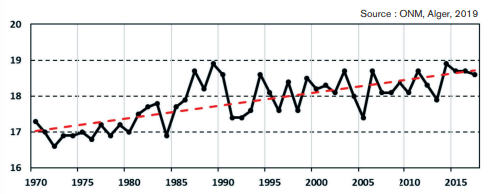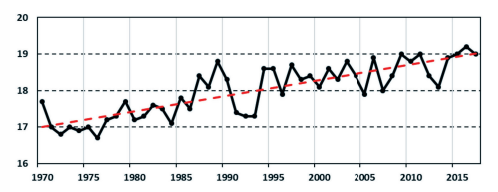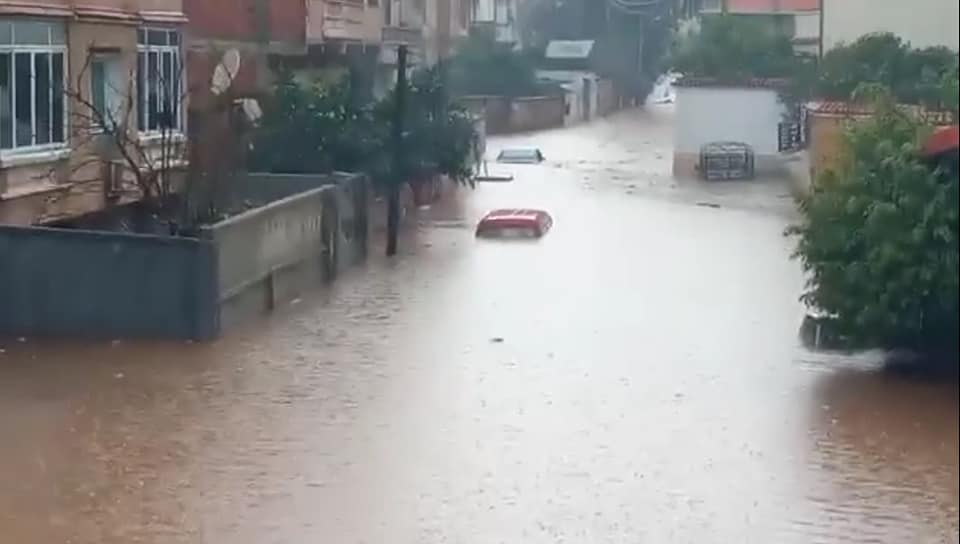
This publication has benefited from the support of the Rosa Luxemburg Foundation. This text may be reproduced in part or in full, provided the source is acknowledged.
In terms of its historical responsibility, Algeria is one of the least contributing countries to climate change. Given the relatively small volume of the country’s emitted greenhouse gases (GHG), Algeria, like other developing countries, is one of the most vulnerable places affected by GHG. This is due to its geographical location, which makes it one of the 24 hot spots that are highly vulnerable to climate change, according to the Intergovernmental Panel on Climate Change (IPCC) (1).
Geographically, Algeria is a North African and Mediterranean country occupying an area of 2,381,741 square kilometers. It is particularly affected by the phenomena of desertification and soil erosion. The climate of most of the country is arid to semi-arid, with a sub-tropical wet climate in some northern regions.
The geographical location significantly affects the dryness of the climate, as the coastline, with its fertile hills, extends only over a 150 km distance, bordered by the mountainous chain of the Tell Atlas (Little Atlas). It receives most of the precipitation from the north and prevents the arrival of wet winds towards the areas of the high plateaus and the south (2).
Climate change in Algeria
Algeria is increasingly facing extreme climate events that have gradually increased its vulnerability. In addition, the recurring periods of drought, which have become longer, have exacerbated the desertification (3) phenomenon. In fact, more than 50 million hectares are currently suffering from a very high level of desertification , where the rural population - consisting mainly of farmers and cattle breeders - are forced to migrate to large cities to ensure their survival. This situation is a direct cause of soil degradation and scarcity of water resources in those areas.
Recent analyzes of climate change have shown that its impacts are now being felt in the Mediterranean region and that it is increasingly leading to the recurrence of unusual and extreme weather events. The scientific community has considered these changes inevitable. In other words, global efforts to mitigate climate change can only partially reduce it. The average annual temperature rise in the Mediterranean region is about 1.5°C above pre-industrial levels (1880-1899) (4).
Current rates of climate change have shown that the effects of global warming on temperatures in the Maghreb, specifically Algeria, are higher than the world average. Whereas the world temperature rise in the twentieth century was 0.74°C, it was between 1.5 and 2°C in the Maghreb, depending on the region - more than twice the global average rise (5).
Moreover, the precipitation decrease ranges between 10 and 20% (6). Thus, Algeria ranked 11th in the world in terms of temperature rise, with an average temperature of about 33°C (7).
Algeria is increasingly facing extreme climate events that have gradually increased its vulnerability. In addition, the recurring periods of drought, which have become longer, have exacerbated desertification. In fact, more than 50 million hectares are currently suffering from a very high level of desertification, where farmers and cattle breeders are forced to migrate to large cities to ensure their survival.
In a study conducted on Algiers (central Algeria) and Oran (northwest Algeria), graphs 1 and 2 show the temperature change between 1970 and 2017. Based on daily temperature data, the two curves indicate that the temperature increased by more than 1.5°C during this period.


As for precipitation, its annual amount ranges between 400 and 1,200 mm per year. Erratic and often very heavy rainfall causes the soil to erode and be deposited as sediment in the depths of dams. There is a striking variation in the levels of precipitation falling in the north and the inland, where we find, for example, the amount of rainfall at the summit of Djurdjura Range (northeast) reaches 1,800 mm per year. Meanwhile, in its south, at a distance of fewer than 10 km, the Sahel Valley receives barely 400 mm. There is also another variation between the eastern and the western regions, where it rains more in the east than in the west.
Graph 3 shows the change in precipitation rates between 1926 and 2006 in the Oran region, for example, and highlights the amount of rainfall decreased by about 15%. Examination of maps made by the National Water Resources Agency for the periods 1942-1989 and 1965-2004 shows that the drought (300-mm isohyet) is shifting significantly towards the north of the country (8), representing one of the indicators of climate change in Algeria.

Regarding water resources, a study conducted by the National Water Resources Agency revealed the impact of climate change on those resources (5). By examining a series of average precipitation data since 1900, the study has shown that rainfall in Algeria decreased by 40% in the west, 30% in the center, and 20% in the east. Climate change has also led to erratic rainfall at the spatial and temporal level, which poses a permanent threat to soil, agriculture, groundwater re-supply, surface run-off, and the sedimentation of dam soil, which consequently causes a lack of dams’ reservoir capacity.
Climate change impacts on Algeria
Water resources are the most vulnerable and susceptible resources to the impact of climate change. According to a statement (9) made by the Ministry of Water Resources, "Algeria, like other Mediterranean countries, is experiencing a water deficit caused by climate changes that have gravely affected the natural cycles of rainfall." The Ministry also said, "The crisis is caused by a significant decline in the water level of dams in the central and western regions of the country, with a deficit rate estimated at 25% of the dam reserves." In another statement (10), the Ministry of Water Resources classified Algeria among the countries poor in water resources due to the long and frequent drought periods, with a deficit in rainfall rates. Algeria witnessed a severe water shortage during the last two years due to the lack of rainfall. It led to the cutting off of the drinking water supplies to the population and the reconsideration of water distribution programs. So far, water is distributed every two or even three days, depending on the region and source of supply. The state has also resorted to preparing water desalination plants as an additional source for supplying potable water in the northern areas because most of the dams have dried up.
Rainfall in Algeria has decreased by 40% in the west, 30% in the center, and 20% in the east. Climate change has also led to erratic rainfall at the spatial and temporal level, which poses a permanent threat to soil, agriculture, groundwater re-supply, surface run-off, and the sedimentation of dam soil, which consequently causes a lack of dams’ reservoir capacity.
Climate change will lead to a further deterioration of general health conditions due to climate-related infectious factors that affect living environments such as water and air. The spread of food/water-borne diseases, such as typhoid, malaria, dysentery, meningitis, and childhood diarrhea, has broadened.
Not only has this situation affected surface water, but it has also depleted groundwater. The state of the Algerian coastal aquifers and the recent developments affecting them have shown that the large deficit in groundwater will increasingly widen. That is in addition to the highly noticeable effects of climate change with a precipitation deficit estimated at around 30% (11).
Regarding food security, climate change has affected the agricultural sector in general; it is becoming increasingly palpable and disturbing, especially with the decrease in the rainfall amount, the degradation of soil quality, and coastal erosion. The numbers have clearly shown the seriousness of the situation, as more than 13 million hectares of land are subject to being washed away - Algeria loses nearly 400,000 hectares annually due to this phenomenon. In addition, since the 1970s, Algeria has suffered from frequent droughts and reduced rainfall, causing disruption of the agricultural calendar and reducing grain yields to up to 50%. Experts expect further decline by 2040, with an expected decrease of 10 to 20% compared to the level recorded in 2011 (12). In addition, the desertification phenomenon has worsened to the extent that an increase in temperature by one degree Celsius would extend the desert area by about 100 km to the north (13). The World Bank report has highlighted that desertification in Algeria threatens more than 17 million hectares of High-Plain Steppes, which are particular geographical and ecological regions characterized by their grassland plains (14).
Regarding the unusual weather events mentioned in the previous report, floods accounted for 60% of the catastrophic events in Algeria over the past 60 years, affecting more than 800,000 people across the country, with economic losses exceeding $1.5 billion. That is because the periods of precipitation have become shorter and heavier, which generated torrential rains and flash floods. The following heavy floods are some examples:
• Floods inundated the Azazaka region on 12 October 1971, claiming the lives of 40 people and affecting 18,000 people, in addition to material losses estimated at 27 million dinars (about $192,583) at the time.
• Floods inundated El-Alama in the state of Setif on 1 September 1980, claiming the lives of 26 people and affecting 9,500 people.
• The floods that hit Jijel on 29 December 1984 claimed the lives of 29 people and affected more than 11,000.
• The floods that inundated Bordj Bou Arreridj on 23 September 1994 led to the death of 16 people and losses estimated at 10 billion Algerian dinars (about $71,146,396).
• The floods in Bab el-Wad in the capital on 10 November 2001 led to 715 fatalities and 115 missing persons, in addition to material losses estimated at 30 billion dinars (about $213,497,111).
• Floods in the city of Ghardaia in southern Algeria in October 2008 led to 43 fatalities, 86 injured, and four missing persons.
It was also estimated that the number of exceptional storms that hit Algeria could increase by about 41%, causing floods, landslides, and severe damage.

Wildfires
Observers have agreed that the summer of 2022 was extremely hot throughout the Mediterranean Region, along with prolonged droughts and devastating forest fires. Recurrent droughts associated with heat waves have become a common phenomenon in many Mediterranean countries and are directly or indirectly related to the consequences of climate change that threaten ecosystems (15).
Water resources are the most susceptible resources to the impact of climate change. The Ministry of Water Resources stated, "Algeria, like other Mediterranean countries, is experiencing a water deficit caused by climate changes that have gravely affected the natural cycles of rainfall."
More than 13 million hectares of land are subject to erosion. Algeria loses nearly 400,000 hectares annually due to this phenomenon. In addition, since the 1970s, Algeria has suffered from frequent droughts and reduced rainfall, causing disruption of the agricultural calendar and reducing grain yields to up to 50%.
The World Bank report has warned that more than 99% of the tree-rich areas in Algeria face the risk of fires, drawing this conclusion from the increasing number of wildfires that have started since 2010, with annual losses estimated at between 15-19 million dollars.
For example, due to a remarkable rise in temperatures, the summer of 2021 witnessed wildfires that devoured 89,000 hectares distributed over 35 states, leaving 90 people dead. As for the year 2022, the wildfires that afflicted eastern Algeria, and in particular the state of El-Tarf, destroyed more than 5,670 hectares of vegetation cover and left 37 people dead (16). It is worth noting that El-Tarf contains Algeria's largest natural reserve, especially in the El-Kala region, which is rich in ecological and biological diversity, as well as beautiful wet areas that have been affected in turn by these wildfires.
Ramifications on individuals and groups
Despite the lack of studies on climate change-related impacts on individuals in Algeria, the above figures related to flood and wildfire victims have shown the severity of these climatic phenomena in the short and medium term. As for the long-term, the repercussions of climate change on the health of individuals have been proven. Some studies conducted in Algeria (17) have indicated that climate change will lead to a further deterioration of general health (18) due to climate-related infectious factors that affect living environments such as water and air. A study on the impact of climate change on individual health has suggested the following:
• The spread of food- and water-borne diseases, such as typhoid fever, malaria, dysentery, meningitis, and childhood diarrhea, has broadened. These diseases are steadily increasing over the years with the decreasing availability of water in quantity and quality in Algeria.
• The vector- and rodent-borne diseases, including parasitic malaria and cutaneous leishmaniasis (CL), previously limited to the desert and dry areas, have increased. However, the infection with CL has been transmitted over the years until it reached more than 25,000 cases in 2005, spreading to areas with milder weather, such as high plateaus. In 2018, the central Algerian states experienced a cholera wave that infected more than 83 people and claimed two lives.
• Air pollution and the respiratory diseases it leads to are considered new health risks, especially in the country's southern regions.
• High temperatures and low precipitation may lead to the spreading of infectious diseases such as trachoma, granulomatous conjunctivitis, bilharzia, and skin diseases, such as Q fever and Nile fever.
Floods accounted for 60% of the catastrophic events in Algeria over the past 60 years, affecting more than 800,000 people across the country, with economic losses exceeding $1.5 billion. That is because the periods of precipitation have become shorter and heavier, which generated torrential rains and flash floods.
Regarding the impact on the population distribution, Algeria already knows a heterogeneous population distribution, with 94% living in the northern regions, representing only 17% of the country's area. That is due to the favorable conditions and facilities suitable for living compared to the inland. However, the spread of drought and water scarcity may increase pressures on these areas, especially with the exacerbation of soil erosion that threatens agricultural lands and farmers. The dryness of the dams is also a bogey that disturbs the economic activities in the concerned areas. The areas of the high plateaus, known for their grazing activities, have suffered in recent years from a lack of vegetation cover from which livestock feed. That adds to the phenomenon of displacement to cities and the abandonment of agricultural lands and related activities, which in turn will exacerbate land degradation and desertification due to non-exploitation.
Expected developments
Several studies have been conducted in Algeria to predict climate change developments, whether on a small or general scale. Most of them have concluded that if policies aimed at adapting and mitigating its repercussions are not implemented, its effects will exacerbate.
In a 2014 study, Thabet Aoul (19) stated that the temperature in Algeria was likely to rise from 1.3 to 2.9°C by the year 2050. He has also expected that the amount of rainfall would be between 10 to 26% lower than it was between 1990 and 2020 and that the northwest and southwest would be the most affected by climate changes. As for the sea level, he expected it to rise by 38 to 55 cm.
Concerning agricultural yield, experts (20) anticipated a decrease from 10 to 20% by 2040 compared to 2011.

In a study conducted for the Ministry of Environment in Algeria, the above maps show the average temperature for the period (1981-2010) and its expected future development (2031-2060 and 2069-2098). The first series of maps has presented the results of the Representative Concentration Path (RCP) 4.5 scenario, which is an optimistic scenario that assumes a decrease in greenhouse gases emitted into the atmosphere. The second series has presented the results of the RCP 8.5 scenario, which is the most pessimistic scenario. The RCP 8.5 scenario assumed that greenhouse gas emissions would not decrease, leading to an increase in the average maximum temperature in Algeria from five to about 6°C by the year 2098.
The World Bank report has warned that more than 99% of the tree-rich areas in Algeria face the risk of fires, drawing this conclusion from the increasing number of wildfires that have started since 2010, with annual losses estimated at between $15-19 million. For example, due to a remarkable rise in temperatures, the summer of 2021 witnessed wildfires that devoured 89,000 hectares distributed over 35 states, leaving 90 people dead.
Concerning rainfall, we can see in the maps the average annual precipitation for the wet period (September-May) in the period (1981-2010) and the development of this average in the future (2031-2060 and 2069-2098). You can see the decrease in the amount of rainfall may reach, per the pessimistic scenario, -150 mm in the period (2069-2098).

The content of this publication is the sole responsibility of Assafir Al-Arabi and Rosa Luxemburg Foundation cannot accept any liability for it.
Translated from Arabic by Sabry Zaki
Published in Assafir Al-Arabi on 27/09/2022
1- Attaqa website on 3 September 2022, https://attaqa.net/2021/12/29
2-First National Communication on Climate Change, Ministry of Environment, March 2001.
3-Nationally Determined Contribution, Republic of Algeria, September 2015.
4-Ministry of Energy Transition and Renewable Energy (MedECC, 2019).
5-National Climate Plan, Ministry of Environment, 2020.
6-Thabet Aoul, 2008.
7-Sakhri Mohamed, Implications of Climate Change on International Security (1989-2016): Algeria Case Study, Master’s Note, University of Algiers 3, 2015-2016.
8-National Water Resources Agency, 2009.
9-Statement by the Ministry of Water Resources, 27 June 2021.
10-Statement by the Ministry of Water Resources on its Facebook account on 3 January 2022.
11-Climate Change and Anthropogenic Activities: Impacts on Coastal Aquifers in Algeria, A. Haouchine, F. Z. Haouchine, A. Labad, I Larhyss Journal 1112-3680 / 2521-9782.
12-White Paper on the Impact of Climate Change in Algeria, Ministry of Energy Transition and Renewable Energies 2021.
13-Mohamed Aachachi, Climate Change and its Impact on Development in Algeria, The Intellectual Dialogue, Volume 11, Issue 12, Pages 232-264, 2016-12-30.
14-See reference number 1 above.
15-Michael Scoullos, WES newsletter (Water and Environment Support), Num 08, September 2022.
16-Skikda: Free vacation for 30 children who were victims of the El-Tarf wildfires, Echorouk Online, an article on 09/06/2022, https://www.echoroukonline.com/
17-The National Action Plan for the Environment and Sustainable Development (PNAEDD), Ministry of Regional Planning and Environment 2002, p. 73.
18- Youcef Laid, national inter-ministerial dialogue on climate change: key health sector, Algiers, August 2010, p. 07.
19-Thabet Aoul MAHI, Climate change and risks, Edition BENMERABET, 2014.
20-See reference number 12 above.





